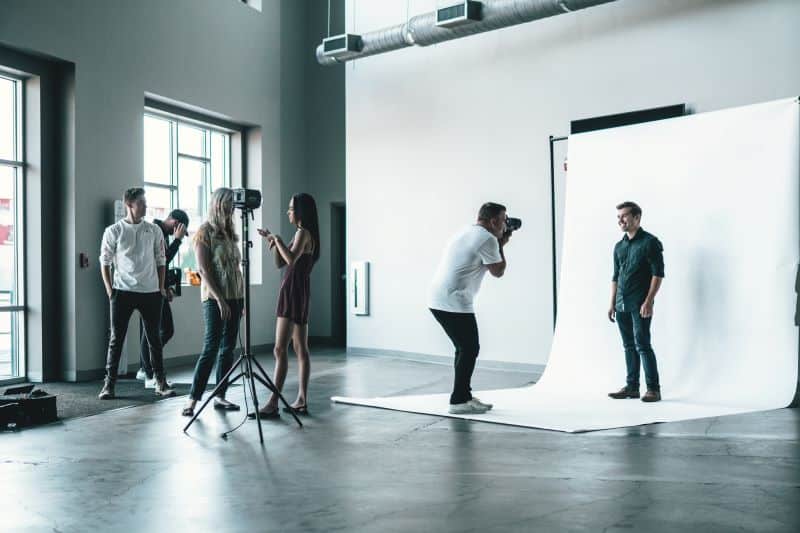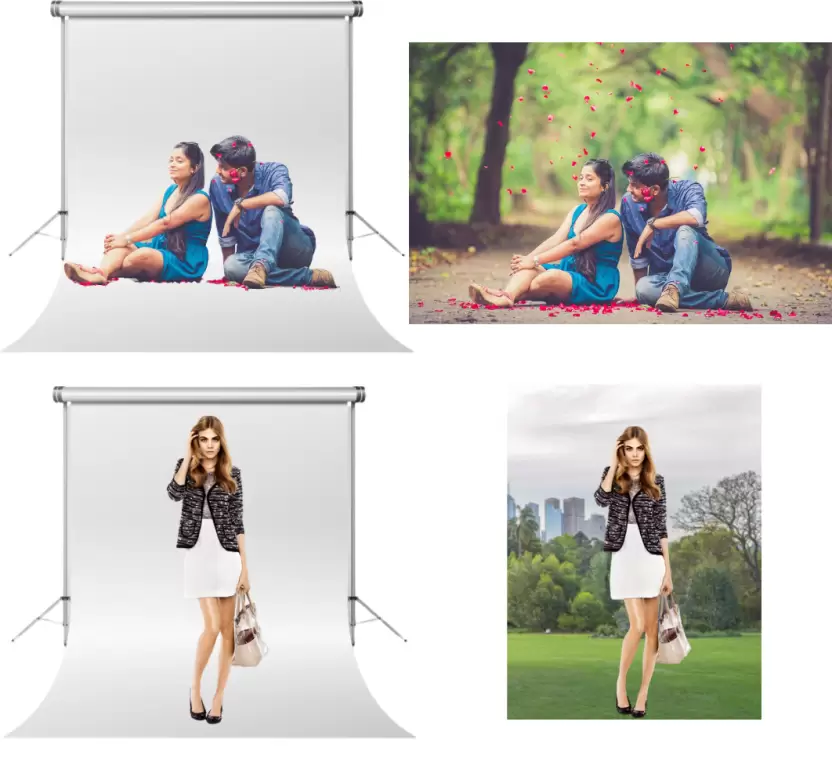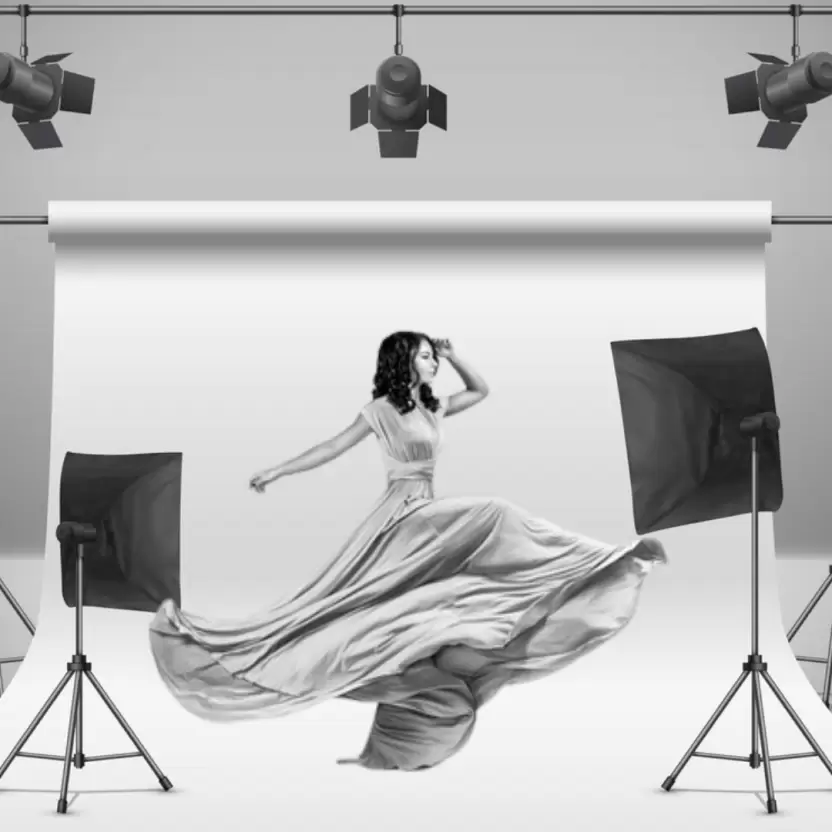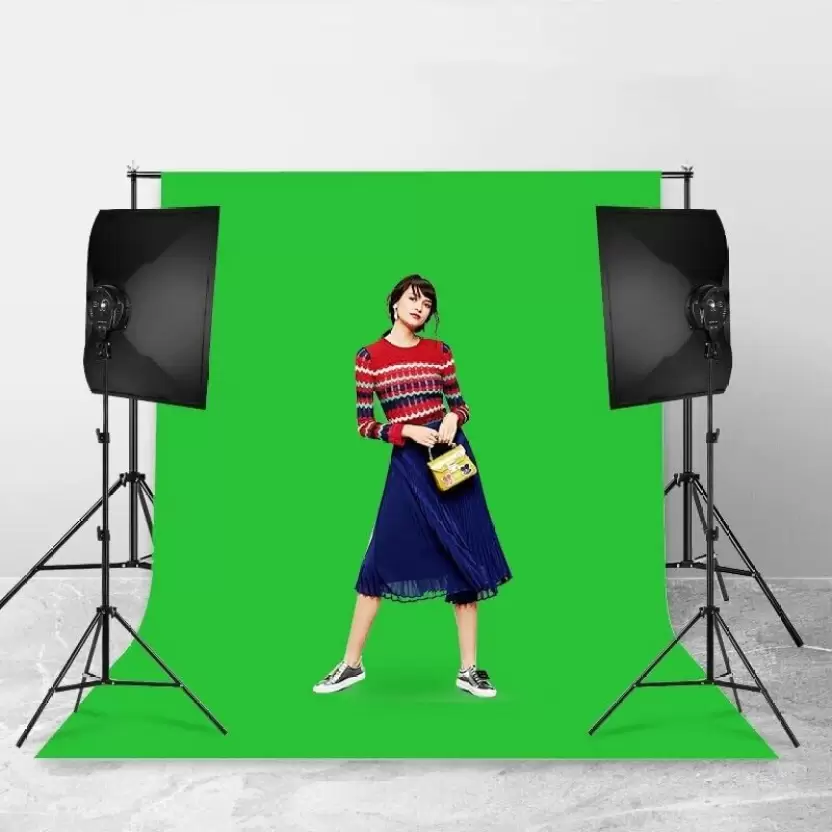Introduction
In photography, the white backdrop is like a silent helper. It’s a plain white sheet that makes things look good in pictures. You might not notice it much, but it’s really important!
Why White Backdrop Matter:
Putting the Spotlight on the Subject
The white background makes whatever you’re taking a picture of stand out. It helps people focus on what’s in the picture without any distractions.
Fits Any Picture
It doesn’t matter what kind of picture you’re taking – portraits, things you’re selling online, or just fun photos. The white background works for all of them, and it never goes out of style.
Makes Editing Easier
When you take a picture with a white background, it’s easier to make it look even better afterwards. You can change things like brightness, colors, and contrast without any fuss.
Letting Creativity Shine
Even though it’s just plain white, you can do lots of cool things with it. You can try different angles, play with how things are lit, and make your pictures look really interesting.
This guide is all about showing you seven simple tricks to make the most of your white backdrop. We’ll share easy tips, fun ways to make your own backdrop, and fix common problems too.
Whether you’re just starting or you’re a pro, get ready to learn how to use a white backdrop to make awesome photos that catch people’s eyes!


1. DIY White Backdrop: Creating Your Canvas
Creating your own white backdrop doesn’t have to be complicated or expensive. With a few simple materials and some creativity, you can craft an effective backdrop that elevates your photography.
Materials Required for a DIY White Backdrop
To get started, you’ll need basic materials that are easy to find:
White Fabric or Paper: Choose a plain white fabric or large sheets of white paper as the base for your backdrop.
Frame or Support: Use a backdrop stand, PVC pipes, or even a clothesline to hang your white fabric or paper.
Clips or Tape: Secure the backdrop to your chosen frame or support to keep it in place.
Step-by-Step Guide to Making a Simple Yet Effective White Backdrop
Here’s a straightforward process to create your DIY white backdrop:
Prepare the Area: Find a space where you can set up your backdrop. Make sure the area is clean and clutter-free.
Hang the White Fabric or Paper: Attach the white fabric or paper to your chosen frame or support. Ensure it’s smooth and free from wrinkles for a clean look in your photos.
Adjust the Lighting: Position your lighting sources correctly to achieve an evenly lit backdrop. Natural light or studio lights can work, depending on your setup.
Test and Adjust: Take test shots to see how the backdrop looks with your subject. Make adjustments to the lighting or backdrop position as needed.
Budget-Friendly Alternatives and Innovative Ideas for Crafting a Backdrop at Home
If you’re looking for alternatives or want to add a creative touch to your DIY backdrop:
Backdrop Alternatives: Experiment with various materials like bedsheets, shower curtains, or even large poster boards painted white.
Texture and Patterns: Add texture or patterns by using textured fabrics or creating hand-painted designs on your backdrop for a unique touch.
Backdrop Mobility: Consider creating a portable backdrop using a collapsible frame or attaching your DIY backdrop to a roller for easy setup and storage.
Creating your DIY white backdrop allows flexibility, customization, and cost-effectiveness, enabling you to capture stunning photos without breaking the bank.


2. Lighting Setup for White Background
Understanding how lighting affects a white background is crucial for achieving fantastic photos. It can significantly impact the mood, clarity, and overall quality of your images.
Understanding the Impact of Lighting on a White Backdrop
Lighting plays a vital role in how your white background backdrop appears in photos. It can make the backdrop look bright and clean or dull and uneven. Different lighting setups create different effects.
Tips for Achieving Optimal Lighting Conditions
To get the best out of your white background backdrop:
1. Even Lighting:
Ensure the light falls uniformly on the backdrop. This helps in avoiding shadows or uneven patches, making the backdrop look consistently white.
2. Soft Lighting:
Soft light, like from a softbox or diffused natural light, reduces harsh shadows and gives a smooth, gentle appearance to the backdrop.
3. Distance and Angle:
Adjust the distance and angle of your light sources to control the brightness and eliminate unwanted glares or reflections.
Use of Natural Light vs. Artificial Light for Different Effects on a White Backdrop
Natural Light:
Soft and Subtle: Natural light can provide a softer, more diffused effect, especially during specific times of the day, like early morning or late afternoon.
Variable Intensity: However, it’s essential to note that natural light can change throughout the day, affecting the consistency of your backdrop’s appearance.
Artificial Light:
Controlled and Consistent: Using artificial lights allows for more control over the intensity and direction of light, ensuring a consistent backdrop appearance.
Customization: Artificial lighting setups offer versatility, letting you experiment with various lighting arrangements to achieve different effects.
Understanding how to manipulate light sources—whether natural or artificial—can help you create the desired atmosphere and enhance the visual impact of your photos against a white backdrop.


3. Professional Tips: Positioning and Composition
When it comes to using a white backdrop, how you position your subject and compose your shot can make a significant difference in the visual impact of your photos.
Importance of Positioning Your Subject in Relation to the White Backdrop
Placing your subject in the right spot concerning the white background backdrop is key to making your subject stand out.
Distance Matters
Keep a good distance between your subject and the backdrop to avoid harsh shadows or unwanted reflections. This helps in creating a clean and distinct outline for your subject against the white background.
Depth and Layering
Consider adding depth by placing your subject away from the backdrop. This can create a subtle depth-of-field effect, making your subject pop while maintaining the backdrop’s clean appearance.
Composition Techniques for Enhancing Visual Appeal Against a White Backdrop
Making the most out of your composition can significantly elevate the appeal of your photos against a white background backdrop.
Rule of Thirds
Vertically and horizontally both, divide your frame into thirds. Position your subject along these lines or at their intersections for a visually engaging composition.
Framing and Leading Lines
Utilize props or natural elements that complement your subject. These elements can act as frames or leading lines, directing focus towards your subject against the backdrop.
Utilizing Negative Space Effectively for a Striking Visual Impact
Negative space, the area around and between the subject, can be a powerful tool when used thoughtfully.
Simplicity Speaks
Allowing ample negative space around your subject against the white background backdrop creates a minimalist yet impactful composition, drawing attention to the subject.
Embracing Minimalism
Don’t be afraid to leave significant areas of the backdrop empty. This can create a sense of serenity and draw the viewer’s eye to the main subject with great impact.
Mastering the art of positioning your subject and employing composition techniques against a white background backdrop opens up possibilities for visually stunning and compelling photographs.


4. When NOT to Use a White Backdrop
A white background backdrop isn’t always the ideal choice for every photography scenario. There are situations where using a white backdrop might not give you the best results.
Discussing Scenarios or Conditions
Low-Contrast Subjects
When capturing subjects that lack contrast or have predominantly white elements, using a white background backdrop may blend the subject into the background, causing it to lose definition and detail.
Overexposure Concerns
In instances where excessive light might be challenging to control, a white background backdrop can easily become overexposed, resulting in loss of texture and details in the background.
Exploring Alternative Backdrop Options
Sometimes, opting for a different backdrop can enhance the visual impact of your photographs. Here are some alternatives worth considering for various photography genres:
Black Backdrop for Drama
In contrast to white, a black backdrop can add drama and depth to portraits or product photography. It emphasizes mood and brings focus to the subject by creating a stark contrast.
Textured or Colored Backdrops for Creativity
Experimenting with textured or colored backdrops can inject creativity into your compositions. Whether it’s a rustic wooden panel, a vibrant cloth, or a patterned background, these alternatives can add personality to your shots.
Environmentally Relevant Backdrops for Context
Utilizing the natural environment or specific locations as backdrops can provide context and storytelling elements to your photographs. Whether it’s an urban setting, a scenic landscape, or an indoor space, incorporating the surroundings can enhance the narrative.
Choosing the right backdrop involves considering the subject, the desired mood, and the overall visual impact you aim to achieve. Sometimes, exploring alternatives beyond the white backdrop can elevate your photography by adding depth, context, or mood to your compositions.
5. Maintaining a Clean White Backdrop
Keeping your white background backdrop clean is crucial to ensure your photos look professional and polished. Here are practical tips to maintain a spotless backdrop:
Practical Tips for Keeping Your White Backdrops Spotless
Maintaining a clean white backdrop doesn’t have to be daunting. Simple routines and tricks can keep it looking pristine:
Regular Dusting and Vacuuming
- Use a soft brush or lint roller to remove dust and lint regularly. If using a fabric backdrop, a handheld vacuum cleaner with a brush attachment works wonders.
Stain Spot Treatments
- Act promptly on stains: Address any spills or marks immediately. Use a gentle cleaning solution suitable for the backdrop material and dab lightly to avoid spreading the stain.
Laundering Fabric Backdrops
- Follow care instructions: If your backdrop is machine washable, adhere to the manufacturer’s instructions for washing and drying to maintain its whiteness.
Cleaning Hacks to Ensure a Pristine Backdrop for Each Photoshoot
Steaming for Wrinkle-Free Backdrops
- Invest in a garment steamer: This is a game-changer for fabric backdrops. A quick steam before each shoot helps remove wrinkles, ensuring a smooth surface.
White Vinegar for Stubborn Stains
- Natural stain remover: Mix water and white vinegar in equal parts. Gently dab the stained area with this solution using a soft cloth to tackle stubborn marks.
Avoiding Direct Contact
- Keep it protected: Avoid direct contact between the backdrop and surfaces that might transfer dirt or color. Use protective sheets or coverings during setups.
Maintaining a clean white backdrop enhances the overall quality of your photos, providing a professional and uncluttered canvas for your subjects.


6. Enhancing White Backdrop Photography: Post-Processing Tricks
Once you’ve captured your images against a white backdrop, refining them through post-processing can elevate their quality and visual appeal.
Introduction to Post-Processing Tools and Software
Post-processing involves using software to tweak and refine your images after they’ve been captured. Here are some common tools and software you can use:
Editing Software
Software like Adobe Photoshop, Lightroom, or GIMP offers a wide range of tools for refining and enhancing your white backdrop images. They allow you to make precise adjustments to various elements in your photos.
Techniques for Contrast, Color Balance and Exposure adjustment
After capturing images against white backdrops, optimizing exposure, contrast, and color balance can significantly enhance the final result.
Adjusting Exposure
Brightness Control: Increase or decrease the overall brightness of your image to ensure that the white backdrop appears crisp and clean without being overexposed.
Highlight and Shadow Adjustments: Fine-tune the highlights and shadows to maintain detail in both the subject and the white backdrop, avoiding any loss of information.
Tweaking Contrast
Contrast Enhancement: Adjust the contrast to make the whites appear brighter and the colors more vibrant, creating a striking contrast between the subject and the backdrop.
Clarity and Sharpness: Enhance clarity and sharpness to make the edges of your subject stand out against the backdrop without losing the natural feel.
Balancing Color
White Balance Adjustment: Ensure the white backdrops appear neutral without any unwanted color casts. Adjust the temperature and tint settings to achieve a clean, pure white background.
Saturation and Vibrancy: Fine-tune the saturation and vibrancy to maintain a consistent look across white backdrops while keeping the subject’s colors true to life.
Post-processing allows you to refine your white background backdrop images, ensuring they look polished and professional, ready to captivate your audience.


7. Experimenting with White Backdrop: Thinking Outside the Box
When it comes to photography, exploring the versatility of a white backdrop opens doors to endless creative possibilities. Here are innovative ideas to expand your horizons:
Creative Ideas for Experimenting with White Backdrops across Different Photography Styles
Portraits with Personality
Silhouette Magic: Experiment with backlighting to create striking silhouette portraits against the white backdrop, emphasizing the outline and mood of the subject.
Color Pop Portraits: Introduce vibrant props or accessories against the white backdrop to make colors pop and add an element of fun to your portraits.
Product Photography Redefined
Minimalist Product Shots: Use the simplicity of white backdrops to showcase products without distractions, highlighting their details and features.
Creative Arrangements: Arrange products creatively against the white backdrop, playing with composition to evoke emotions or tell a story.
Showcasing Examples and Case Studies of Innovative Use of White Backdrops
Fashion Photography Elegance
High-Key Fashion Shoots: Employ white backdrops for high-key fashion shoots, focusing on the model and clothing details for a clean, sophisticated look.
Contrast and Drama: Create dramatic contrasts by incorporating shadow play against the white background backdrop, adding depth and intrigue to fashion photography.
Artistic Expressions in Still Life
Artful Arrangements: Use the white backdrop as a canvas for still life compositions, experimenting with different textures, objects, and lighting for artistic visuals.
Play of Shadows: Utilize shadows against white backdrops to add dimension and mood to your still life creations, crafting visually compelling images.
Exploring these innovative uses of a white background backdrop across various photography genres can inspire fresh perspectives and unlock your creative potential, allowing your photos to stand out in a crowd.


FAQ: Common Problems and Solutions with White Backdrop
White Background Backdrop Lighting Issues
How to Light a White Backdrop?
Proper lighting is crucial for a flawless white background. To light it evenly:
- Position lights on both sides to eliminate shadows.
- Use softboxes or diffusers to create a uniform light.
- Adjust the intensity to avoid overexposure but ensure it’s bright enough to maintain the backdrop’s whiteness.
Video Recording with a White Screen Backdrop
How to Set up a White Backdrop for Videos?
When setting up a white screen backdrop for video:
- Ensure good lighting to avoid shadows on the screen.
- Iron or steam the backdrop to remove wrinkles for a clean look.
- Position the subject at a suitable distance to prevent shadows from falling onto the backdrop.
Where to Get a White Backdrop for Photography?
You can find white backdrops in various places:
- Online Retailers: Websites like Amazon.com, Etsy or Wonder Products offer a wide range of options.
- Photography Stores: Local stores specializing in photography equipment usually stock backdrops.
- DIY: Create your own using white fabric or paper, as explained in the DIY section earlier.
White Chroma Key and Editing Software
What are the Common White Chroma Key Issues?
White chroma key issues can include:
- Uneven Lighting: Causes inconsistencies in the white background backdrop, making editing difficult.
- Shadows and Reflections: These can affect the chroma key process, causing inconsistencies in the final edit.
Which Editing Software is Best for Handling White Backdrop Issues?
Popular editing software like Adobe Photoshop, Lightroom, and Premiere Pro offer tools to address white backdrop issues:
- Use tools like levels, curves, and exposure adjustments to fix lighting inconsistencies.
- Chroma key features help in removing the white screen backdrop and replacing it with a different background.
White Background Backdrop Chroma Keying in Adobe Photoshop
1. Why is the White Background Challenging for Chroma Keying?
The uniformity of white can make it tricky to distinguish the edges and separate the subject from the backdrop during chroma keying.
2. How to Ensure Consistent Lighting for a White Background?
Maintaining even lighting across the white backdrop minimizes shadows and helps during the chroma key process. Achieve uniform illumination by using multiple light sources.
3. What Tools Can Help with Chroma Keying a White Backdrop in Photoshop?
Adobe Photoshop offers various tools to aid in chroma keying, such as the Magic Wand tool, Select Subject feature, and the Refine Edge Brush for precise selections.
4. How to Tackle Imperfections or Shadows on a White Backdrop?
Utilize Photoshop’s Clone Stamp or Healing Brush tool to remove imperfections or shadows on the white backdrop before starting the chroma key process.
5. What’s the Key to Achieving a Clean Cut-Out with a White Backdrop?
Employ the Refine Edge or Select and Mask feature in Photoshop for fine-tuning selections and enhancing the edges of the subject against the white background.
6. Can Photoshop Help Replace a White Background with a Different Image?
Yes, Photoshop’s layer masks and blending options facilitate replacing the white background with another image or background of your choice post-chroma keying.
7. How to Avoid Color Spill or Reflections When Using a White Backdrop?
To prevent color spill or reflections on the subject due to the white backdrop, ensure proper distancing, and avoid harsh lighting that could bounce off the backdrop onto the subject.
8. What Are the Common Mistakes to Avoid When Chroma Keying a White Background in Photoshop?
Common mistakes include overlooking subtle shadows, uneven lighting, and ignoring details during selection refining, leading to a less convincing cut-out.
9. What Steps Can Enhance the Overall Look of a Final Image After Chroma Keying a White Background?
Post-chroma keying, use adjustment layers in Photoshop to fine-tune colors, contrast, and brightness to ensure a seamless integration of the subject with the new background.
10. Any Tips for Efficient Workflow While Chroma Keying a White Backdrop in Photoshop?
Organize your layers, make use of Photoshop’s shortcuts, and save selections to streamline the process and maintain flexibility in editing.



